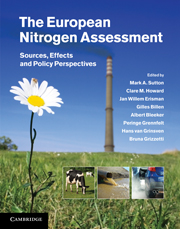Book contents
- Frontmatter
- Contents
- List of contributors
- Foreword
- Summary for policy makers
- Technical summary
- 1 Assessing our nitrogen inheritance
- Part I Nitrogen in Europe: the present position
- 2 The European nitrogen problem in a global perspective
- 3 Benefits of nitrogen for food, fibre and industrial production
- 4 Nitrogen in current European policies
- 5 The challenge to integrate nitrogen science and policies: the European Nitrogen Assessment approach
- Part II Nitrogen processing in the biosphere
- Part III Nitrogen flows and fate at multiple spatial scales
- Part IV Managing nitrogen in relation to key societal threats
- Part V European nitrogen policies and future challenges
- Glossary
- Index
- References
2 - The European nitrogen problem in a global perspective
from Part I - Nitrogen in Europe: the present position
Published online by Cambridge University Press: 16 May 2011
- Frontmatter
- Contents
- List of contributors
- Foreword
- Summary for policy makers
- Technical summary
- 1 Assessing our nitrogen inheritance
- Part I Nitrogen in Europe: the present position
- 2 The European nitrogen problem in a global perspective
- 3 Benefits of nitrogen for food, fibre and industrial production
- 4 Nitrogen in current European policies
- 5 The challenge to integrate nitrogen science and policies: the European Nitrogen Assessment approach
- Part II Nitrogen processing in the biosphere
- Part III Nitrogen flows and fate at multiple spatial scales
- Part IV Managing nitrogen in relation to key societal threats
- Part V European nitrogen policies and future challenges
- Glossary
- Index
- References
Summary
Executive summary
Nature of the problem
Reactive nitrogen has both positive and negative effects on ecosystems and human health. Reactive nitrogen is formed through the use of fossil fuels releasing large amounts of nitrogen oxides into the atmosphere and through the production of ammonia by the Haber–Bosch process and using it in agriculture to increase our food, feed and fuel production. While the use of nitrogen as a fertilizer and chemical product has brought enormous benefits, losses of fertilizer nitrogen and combustion nitrogen to the environment lead to many side effects on human health, ecosystem health, biodiversity and climate.
Approaches
The European nitrogen problem is placed in a global perspective, showing the European nitrogen fixation, transport and environmental impacts compared with different regions of the globe.
Key findings/state of knowledge
Humans, largely through agriculture, but also through burning of fossil fuels, have had a huge impact on the nitrogen budget of the Earth. Europe is one of the leading producers of reactive nitrogen, but it is also the first region in the world where the issue was recognized and in some parts of Europe the reactive nitrogen losses to the environment started to decrease. Europe is a nitrogen hotspot in the world with high nitrogen export through rivers to the coast, NOx and particulate matter concentrations and 10% of the global N2O emissions.
[…]
- Type
- Chapter
- Information
- The European Nitrogen AssessmentSources, Effects and Policy Perspectives, pp. 9 - 31Publisher: Cambridge University PressPrint publication year: 2011
References
- 42
- Cited by



